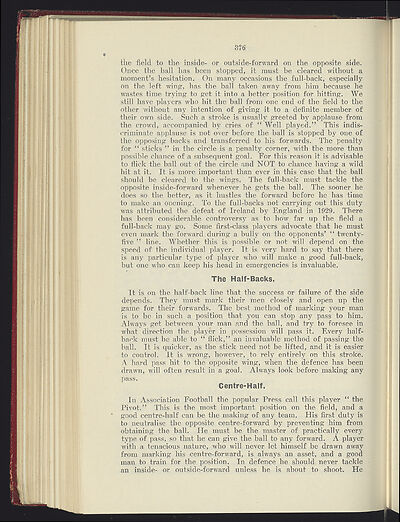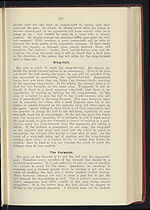1931
(390)
Download files
Complete book:
Individual page:
Thumbnail gallery: Grid view | List view

376
the field to the inside- or outside-forward on the opposite side.
Once the ball has been stopped, it must be cleared without a
moment's hesitation. On many occasions the full-back, especially
on the left wing, has the ball taken away from him because he
wastes time trying to get it into a better position for hitting. We
still have players who hit the ball from one end of the field to the
other without any intention of giving it to a definite member of
their own side. Such a stroke is usually greeted by applause from
the crowd, accompanied by cries of " Well played." This indis-
criminate applause is not over before the ball is stopped by one of
the opposing backs and transferred to his forwards. The penalty
for " sticks " in the circle is a penalty corner, with the more than
possible chance of a subsequent goal. For this reason it is advisable
to flick the ball out of the circle and NOT to chance having a wild
hit at it. It is more important than ever in this case that the ball
should be cleared to the rings. The full-back must tackle the
opposite inside-forward whenever he gets the ball. The sooner he
does so the better, as it hustles the forward before he has time
to make an opening. To the full-backs not carrying out this duty
was attributed the defeat of Ireland by England in 1929. There
has been considerable controversy as to how far up the field a
full-back may go. Some first-class players advocate that he must
even mark the forward during a bully on the opponents' " twenty-
five " line. Whether this is possible or not will depend on the
speed of the individual player. It is very hard to say that there
is any particular type of player who will make a good full-back,
but one who can keep his head in emergencies is invaluable.
The Half-Backs.
It is on the half-back line that the success or failure of the side
depends. They must mark their men closely and open up the
game for their forwards. The best method of marling your man
is to be in such a position that you can stop any pass to him.
Always get between your man and the ball, and try to foresee in
what direction the player in possession will pass it. Every half-
back must be able to " flick," an invaluable method of passing the
ball. It is quicker, as the stick need not be lifted, and it is easier
to control. It is wrong, however, to rely entirely on this stroke.
A hard pass hit to the opposite wing, when the defence has been
drawn, will often result in a goal. Always look before making any
pass.
Centre-Half.
In Association Football the popular Press call this player " the
Pivot." This is the most important position on the field, and a
good centre-half can be the making of any team. His first duty is
to neutralise the opposite centre-forward by preventing him from
obtaining the ball. He must be the master of practically every
type of pass, so that he can give the ball to any forward. A player
with a tenacious nature, who will never let himself be drawn away
from marking his centre-forward, is always an asset, and a good
man to train for the position. In defence he should never tackle
an inside- or outside-forward unless he is about to shoot. He
the field to the inside- or outside-forward on the opposite side.
Once the ball has been stopped, it must be cleared without a
moment's hesitation. On many occasions the full-back, especially
on the left wing, has the ball taken away from him because he
wastes time trying to get it into a better position for hitting. We
still have players who hit the ball from one end of the field to the
other without any intention of giving it to a definite member of
their own side. Such a stroke is usually greeted by applause from
the crowd, accompanied by cries of " Well played." This indis-
criminate applause is not over before the ball is stopped by one of
the opposing backs and transferred to his forwards. The penalty
for " sticks " in the circle is a penalty corner, with the more than
possible chance of a subsequent goal. For this reason it is advisable
to flick the ball out of the circle and NOT to chance having a wild
hit at it. It is more important than ever in this case that the ball
should be cleared to the rings. The full-back must tackle the
opposite inside-forward whenever he gets the ball. The sooner he
does so the better, as it hustles the forward before he has time
to make an opening. To the full-backs not carrying out this duty
was attributed the defeat of Ireland by England in 1929. There
has been considerable controversy as to how far up the field a
full-back may go. Some first-class players advocate that he must
even mark the forward during a bully on the opponents' " twenty-
five " line. Whether this is possible or not will depend on the
speed of the individual player. It is very hard to say that there
is any particular type of player who will make a good full-back,
but one who can keep his head in emergencies is invaluable.
The Half-Backs.
It is on the half-back line that the success or failure of the side
depends. They must mark their men closely and open up the
game for their forwards. The best method of marling your man
is to be in such a position that you can stop any pass to him.
Always get between your man and the ball, and try to foresee in
what direction the player in possession will pass it. Every half-
back must be able to " flick," an invaluable method of passing the
ball. It is quicker, as the stick need not be lifted, and it is easier
to control. It is wrong, however, to rely entirely on this stroke.
A hard pass hit to the opposite wing, when the defence has been
drawn, will often result in a goal. Always look before making any
pass.
Centre-Half.
In Association Football the popular Press call this player " the
Pivot." This is the most important position on the field, and a
good centre-half can be the making of any team. His first duty is
to neutralise the opposite centre-forward by preventing him from
obtaining the ball. He must be the master of practically every
type of pass, so that he can give the ball to any forward. A player
with a tenacious nature, who will never let himself be drawn away
from marking his centre-forward, is always an asset, and a good
man to train for the position. In defence he should never tackle
an inside- or outside-forward unless he is about to shoot. He
Set display mode to:
![]() Universal Viewer |
Universal Viewer | ![]() Mirador |
Large image | Transcription
Mirador |
Large image | Transcription
| Games and sports in the army > 1931 > (390) |
|---|
| Permanent URL | https://digital.nls.uk/248676445 |
|---|
| Description | 'Games and Sports in the Army' was an annual publication produced by the British War Office between the 1930s and 1960s. This included the Second World War. It outlines the rules and regulations for games and sports played by members of the armed forces. It features names and photographs of team members, and examples of contemporary advertising. |
|---|---|
| Shelfmark | GWB.52 |

